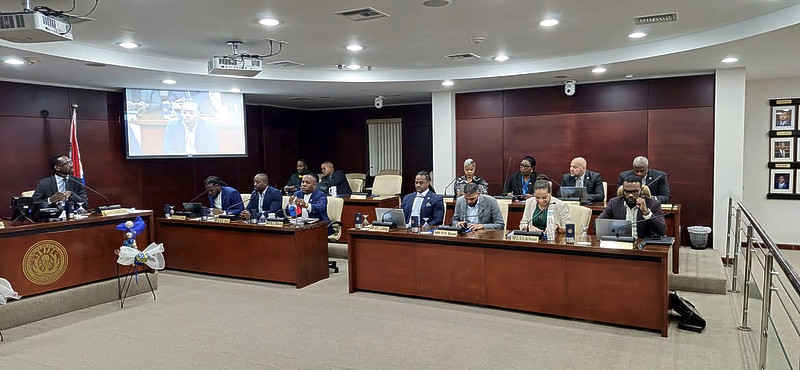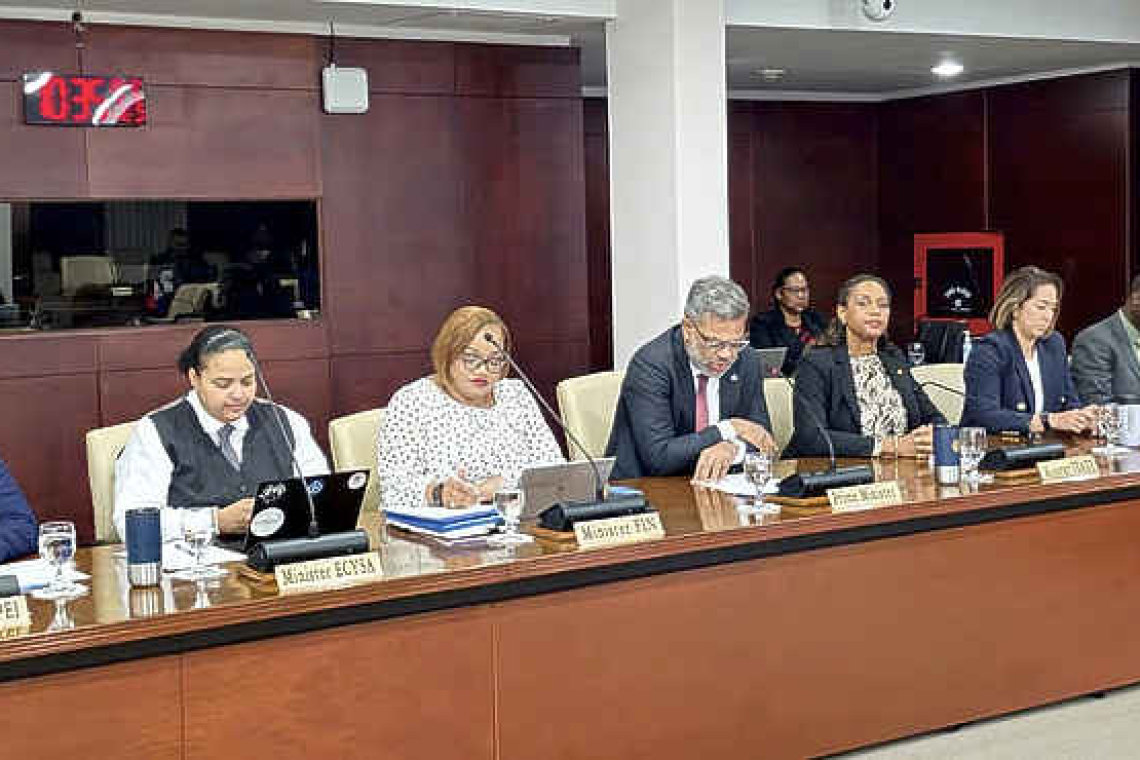Members of the Council of Ministers in Parliament on Wednesday for the start of the central committee meeting on the draft 2025 budget.
PHILIPSBURG--Finance Minister Marinka Gumbs on Wednesday tabled what she referred to as a “conservative” draft 2025 budget which shows a projected income of NAf. 574 million and expenditure of NAf. 572 million.
This figure is expected to steadily climb in the coming years. For 2026, NAf. 608 million of income and NAf. 593 million of expenditures are projected; for 2027, NAf. 624 million and NAf. 610 million of income and expenditures, respectively; and for 2028, NAf. 632 million in income and NAf. 623 million in expenditures.

MPs during the budget debate.
The Minister said revenue estimates for the 2025 budget are based on historical data from Quarter 2 (Q2) of 2024, forecasted and adjusted to align with gross domestic product (GDP) projections. Similarly, expenditure estimates are grounded in Q2 data, with necessary adjustments for inflation, union agreements, and existing obligations. As this is a policy-neutral budget, the potential for substantial surpluses in 2024 and 2025 is limited. The 2025 draft budget includes only initiatives that began in 2024 and are expected to continue into 2025, alongside the anticipated effects of economic growth.
Tax revenue
According to Minister Gumbs, the projected revenues and tax structure for the coming years are closely linked to economic growth. “As the economy expands, tax revenues naturally increase due to higher corporate profits, rising individual incomes, and increased consumption, impacting taxes such as income tax, profit tax, and turnover tax (TOT). Conversely, economic slowdowns typically lead to reduced revenues.”
For 2025, government anticipates a 3% correlation between economic growth and tax revenues. However, these estimates are subject to actual economic performance and require careful monitoring and adjustments as needed, she explained.
Tax revenues for 2025 are projected at NAf. 453 million, up from NAf. 426 million in 2024. The minister said this growth is largely driven by increased wage and turnover taxes, supported by new construction projects that are expected to stimulate employment and consumption.
“By 2026, the introduction of the tourist tax, projected to generate NAf. 18 million annually, will provide a notable boost to revenues. Additionally, while further tax reforms and improvements in tax administration are planned, their impact is expected to be realized in the longer term. On the permits front, heightened construction activity is expected to lead to a rise in work and residence permit applications, contributing an estimated NAf. 1 million annually through 2027.”
She said revenues from fees and concessions, such as GEBE’s concession fees, are also projected to grow steadily, driven by inflation adjustments, with total concession fees expected to reach NAf. 9 million by 2027.
Other revenue streams are expected to remain stable, with incremental gains from initiatives such as the SPEAR project under the Trust Fund. This project, focused on enhancing institutional capacity and operational effectiveness, is set to contribute US $23 million between 2025 and 2028.
“While these projections indicate a stable revenue outlook, they remain sensitive to economic fluctuations and require ongoing vigilance to adapt to evolving circumstances.”
In the area of permits, revenues are expected to grow by NAf. 2 million due to increased demand for work and residence permits, especially for skilled professionals in the construction sector.
Fees and concessions remain stable, with consistent revenues from banking license fees, concession fees, and casino and lottery fees. These categories show no significant changes compared to the 2024 budget amendment.
Other revenues, however, are projected to decrease from NAf. 46 million in 2024 to NAf 41 million in 2025, primarily due to the absence of one-off items included in the 2024 amendment, such as retroactive land lease payments. Project funds are adjusted annually based on approved plans, with NAf. 17 million allocated for 2025, including contributions for border control and tax reform. “This initiative, along with other planned projects, reflects the government’s efforts to align revenues with realistic projections and strategic priorities for sustainable growth,” the minister said.
Expenses
As it relates to expenditure, the Minister said government’s multi-year projections are based on several key assumptions across economic categories. Under personnel costs, she said for 2025, a 2% salary indexation and a 1% increase in vacation allowance are included, along with allowances for bonuses and step increases. From 2026 onwards, adjustments for vacancies and changes in job classifications due to digitization will lead to higher costs. Besides this the operations of the new prison will lead to an increase in personnel becoming significant from 2027, by NAf. 2.5 million.
In the area of Goods and Services, she said moderate growth is expected, as inflation is projected to remain stable at 2- 2.3% annually. The SPEAR project, funded with US $23 million, will support institutional capacity and contribute to cost increases under this category.
As it relates to social provisions and healthcare, she said rising costs are anticipated due to the aging population, with seniors increasing from 5% of the population in 2011 to 13% in 2022. According to the minister, structural reforms are needed to address an average annual healthcare fund deficit of NAf. 50 million.
And for subsidies, she indicated that a slight increase is included for schools, with further adjustments expected following the evaluation of the funding system by 2026.
For interest payment, she indicated that the refinancing of liquidity support loans at a reduced interest rate of 2.9% will slightly mitigate the impact. “These projections emphasize the need for careful monitoring, timely reforms, and efficient use of resources to maintain financial sustainability in the coming years."
The minister explained that personnel costs have increased by NAf. 15 million compared to the 2024 budget amendment. This increase is primarily due to the reclassification of certain expenses, such as outsourced labour, meals, and uniforms, from material costs to personnel expenses.
As part of the Financial Management Steps project, the minister said a new accounting system and chart of accounts will be implemented starting January 1. “This reclassification aligns these costs under personnel expenses as they pertain to secondary benefits and outsourced labour serving as an extension of the workforce.”
The increase in personnel costs is attributed to several factors including the reclassification of outsourced labour, meals, and uniforms amounting to NAf. 8 million; the 2% salary indexation amounting to NAf. 4 million; the Step increases and jubilee bonuses amounting to +NAf. 2 million; increase in vacation pay from 6% to 7% amounting to +NAf 2 million and a reduction in severance pay which is NAf. 1 million.
As it relates to material costs, these have decreased by NAf. 1 million compared to the 2024 budget amendment. The decrease includes a NAf. 8 million reduction in goods and services due to the reclassification of costs to personnel expenses. However, this is offset by increases in depreciation (+NAf. 2 million) and interest and bank charges (+NAf. 5 million), primarily from new capital investments and refinancing agreements.







